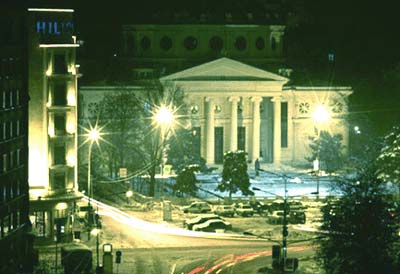|
|
Bucharest
"The Little Paris of the East"
|
 |
The
Romanian Atheneum, a symbol of the city as far back as its 1888
inauguration.
The
first concert of the Bucharest Philharmonic Orchestra took place on
March 5, 1889, under the Atheneum's dome. |
The name of the city
Romanian legend has it that the city of Bucharest was founded by a
shepherd named "Bucur", whose name means "joy". His flute playing
reportedly dazzled the locals and his hearty wine from nearby vineyards
endeared him to the local traders, who gave his name to the place.
History
The town was first mentioned in a document in 1495 as residence of the
ruler of Wallachia, Vlad Tepes (Vlad the Impaler, known also as
Dracula). But settlement has an older history, going back to the 14th
century. The founding of Bucharest is traditionally ascribed to a
peasant named Bucur, but no record of the city exists prior to the late
Middle Ages. Attacks by Tatars and Turks restricted its growth before
the 17th century. Between the 17th - 19th (begining with 1698) centuries
it was the capital of Wallachia and in 1862 it became the capital of
Romania. The population increased in number from 122,000 (1859) to
639,000 (1930) to 1,452,000 (1966). The town held a dominant position in
the national context similarly to the position held by Budapest in
Hungary, Vienna in Austria or Paris in France.
Heavy fighting near the Palace Square during the revolution that ousted
the Ceausescu regime in December 1989 caused damage to prominent
landmarks, including the Royal Palace.
Bucharest architecture
 |
You will be intrigued by the
city's eclectic mixture of architecture, from Curtea Veche, the
remains of Prince Vlad Tepes 15th century palace - he was the city's
founder as well as the inspiration for "Dracula", - to Orthodox
Churches, Second Empire mansions, the stolid Stalinist architecture
of the communist years and the colossal 6,000 room Parliament House,
the second largest building in the world after the Pentagon.
Bucharest's museums are a
destination in themselves, especially the open-air Muzeul Satului
(Village Museum) in the Herastrau Park near the Arcul de Triumf.
Here you will find village architecture and crafts from all over
Romania, including wooden churches from Maramures. |
Bucharest civic centerThe "Civic
Center" is a portion of Bucharest which was completely rebuilt as
part of the scheme of systematization under the dictator Nicolae
Ceausescu.
Bucharest Civic Center includes numerous government offices and
apartments, the latter being roughly equal in number to the housing
units destroyed for its construction. The apartments were originally
intended to house Romania's communist elite, but the completed
complex is a rather bland and unappealing neighborhood, certainly
not a preferred residence for the city's new capitalist elite, with
the possible exception of buildings that look out on the
now-bustling Unirea Square, where the Civic Center bisects the
Dāmbovita River, which is channelled underground past the Square. |
University
square
University Square is the place in central Bucharest where students
were shot dead during Romania's 1989 anti-communist revolution.
|
|
Victory road
Calea Victoriei (Avenue of
Victory), on the site of the wood-paved Podul Mogosoaiei, has been
Bucharest's most fashionable street since boyars first built their
residences along it.
|
|



